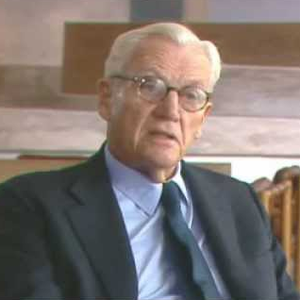Joseph Irwin Miller
( businessman) | |
|---|---|
 | |
| Born | 26 May 1909 |
| Died | August 19, 2004 (Age 95) |
| Nationality | US |
| Alma mater | • Taft School • Yale University • Balliol College (Oxford) |
| Member of | Bohemian Grove, Council on Foreign Relations/Historical Members, Links Club |
US industrialist and architecture patron. | |
Joseph Irwin Miller was an American industrialist, patron of modern architecture, and lay leader in the Christian ecumenical movement and civil rights. He was instrumental in the rise of the Cummins Engine Corporation and giving his hometown of Columbus, Indiana international stature with its modern architecture buildings.[1]
Biography
Miller was born in Columbus, Indiana to Hugh Thomas Miller, a college professor and politician, and Nettie Irwin Sweeney. He had one sister, Elizabeth Clementine Miller (Mrs. Robert Stone Tangeman) (1905–1996).
Miller was a 1931 graduate of Yale University and made Phi Beta Kappa. From 1931 to 1933 he studied Philosophy, Politics and Economics (PPE) at Balliol College, Oxford, which made him an Honorary Fellow in 1974.
On February 5, 1943, he married Xenia Simons.[2] They had three daughters, Margaret, Catherine, Elizabeth, and two sons, Hugh and William. He had ten grandchildren, Jonathan, Zachary, Joshua, Benjamin, Aaron, Andrew, AnnaCatherine, Katherine, Laura, and Emily.
The Miller House which was designed by Eero Saarinen, was declared a U.S. National Historic Landmark in 2000. In 2010, after the death of Mrs. Miller, the house was donated to the Indianapolis Museum of Art. The family's Canadian summer home on Lake Rosseau in Windermere, Ontario was also designed by Saarinen.
Work
Miller joined Cummins, the family business, in 1934. He was executive vice president from 1944 to 1947, president from 1947 to 1951, and chairman from 1951 to 1977. He was a lieutenant in the U.S. Navy in the South Pacific during the Second World War.[1]
In 1950, Miller helped to establish the National Council of Churches (NCC) and later served as its first lay president (1960–63). Miller chaired the NCC's Commission on Religion and Race, which coordinated organized religion’s support for strong civil rights legislation, and jointly sponsored the March on Washington. He led religious delegations that met with Presidents John F. Kennedy and Lyndon Johnson to push for the legislation that became the Civil Rights Act of 1964.
In 1954, he established the Cummins Foundation and in 1957 made an offer to Columbus that the foundation would pay all the architects fees for new public buildings in Columbus. Thus this small Midwestern city has buildings by Eero Saarinen, Eliel Saarinen, I.M. Pei, Kevin Roche, Richard Meier, Harry Weese, César Pelli, Gunnar Birkerts, and Skidmore, Owings & Merrill, many of which feature extensive interiors designed by Alexander Girard. "Some people have a tombstone at the head of their gravesite or at the foot of it," Columbus resident William Beaver wrote. "Mr. Miller had the whole town as a monument." The American Institute of Architects in 1991 declared Columbus America's sixth most important city in terms of architecture. In addition to altruism, Miller used architecture to entice the best people to work for Cummins.[3]
Miller served as a Trustee of the Ford Foundation and Yale University, and as a director of Chemical Bank. He established the Irwin-Sweeney-Miller Foundation, which supports numerous charities and institutions—notably, Christian Theological Seminary in Indianapolis and Emma Willard School, a leading girls' preparatory school in Troy, NY. The family's business interests were widespread, and he served at various times as Chairman of Irwin Union Bank in Columbus IN, Union Starch and Refining Company, and Irwin Management Company.
Irwin Management was the family's private wealth-management and services organization, funded from Mr. Miller's large Cummins Engine Co. dividends and from the income generated by other holdings. The group managed all of the family's assets except Cummins Engine—which Mr. Miller managed personally, as President and later as Chairman. IMCO, as it was called, was divided into departments for Marketable Securities, Oil and Gas, Real Estate, Venture Capital, Financial Planning and Analysis, and Family Services. The company was staffed by about 20 professionals, many of whom had MBA degrees from the leading graduate business schools (e.g., Harvard, Columbia, Chicago, Carnegie-Mellon, Stanford, Oxford). In addition to financial management, the company provided staff services to assist Mr. Miller's roles in philanthropic, foundation, directorship, and trustee positions. It was considered a high-status firm among MBA students, and there was spirited competition for jobs at IMCO upon graduation.
He was active in politics, persuading New York governor Nelson A. Rockefeller to run for president in 1968 (and served as national campaign chairman) and in 1972 he supported New York City Mayor John Lindsay's presidential bid.[1]
Miller was also a trustee of the Museum of Modern Art, the Ford Foundation, and was a member of the Yale Corporation, which governs the university. In 1986 he received the National Building Museum's first Honor Award.[4]
Legacy
Upon Miller's death in 2004, the National Council of Churches in the United States instituted an annual J. Irwin Miller Award. The award is presented annually to "a lay person who has been a witness, through action in the world, to justice and other values affirmed by Christian faith, and who has demonstrated a commitment to church unity."[5]
In 2016 Exhibit Columbus launched the J. Irwin and Xenia S. Miller Prize, an award given to artists, architects, and designers whose work is for the benefit of communities.
Event Participated in
| Event | Start | End | Location(s) | Description |
|---|---|---|---|---|
| Bilderberg/1977 | 22 April 1977 | 24 April 1977 | Imperial Hotel Torquay UK | The 25th Bilderberg, held in Torquay, England. |
References
- ↑ Jump up to: a b c https://www.nytimes.com/2004/08/19/business/j-irwin-miller-95-patron-of-modern-architecture-dies.html
- ↑ https://web.archive.org/web/20080602010243/http://www.yale.edu/ism/events/XeniaMiller.html
- ↑ https://www.fastcodesign.com/3064965/wanderlust/the-little-known-midwestern-town-that-modernism-built
- ↑ Honor Award
- ↑ http://www.ncccusa.org/news/051121GAAwards.html